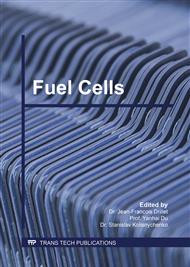[1]
D. O. Dunikov, V. I. Borzenko, S. P. Malyshenko, D. V. Blinov, A. N. Kazakov, Prospective technologies for using biohydrogen in power installations on the basis of fuel cells (a review), Therm. Eng. 60(3) (2013) 202-211.
DOI: 10.1134/s0040601512110043
Google Scholar
[2]
M. Yu. Zubkova, V. I. Maslikov, D. V. Molodtsov, A. N. Chusov, The ways assessment of direct production electricity and heat from hydrogenous fuel based on biogas for autonomous consumers, Appl. Mech. Mater. 587-589 (2014) 330-337.
DOI: 10.4028/www.scientific.net/amm.587-589.330
Google Scholar
[3]
P. L. Micheli, M. C. Williams, F. A. Sudhoff, inventors; The United States of America as represented by the United States Department of Energy, assignee. Indirect-fired gas turbine dual fuel cell power cycle, United States patent US 5, 541, 014 (July 30, 1996).
Google Scholar
[4]
R. A. Geisbrecht, M. C. Williams, inventors; The United States of America as represented by the Department of Energy, assignee. Fuel cell-fuel cell hybrid system. United States patent US 6, 623, 880 (September 23, 2003).
Google Scholar
[5]
B. G. Keefer, inventor; QuestAir Technologies Inc., assignee. High temperature fuel cell power plant. United States patent US 7, 097, 925 (August 29, 2006).
Google Scholar
[6]
B. G. Keefer, D. J. Connor, C. F. Hunter, inventors; QuestAir Technologies Inc., assignee. Energy efficient gas separation for fuel cells. United States patent US 7, 087, 331 (August 8, 2006).
Google Scholar
[7]
G. Gahleitner, Hydrogen from renewable electricity: An international review of power-to-gas pilot plants for stationary applications, Int. J. Hydrogen Energy, 38(5) (2013) 2039-(2061).
DOI: 10.1016/j.ijhydene.2012.12.010
Google Scholar
[8]
A. N. Chusov, M. Yu. Zubkova, V. V. Korablev, V. I. Maslikov, D. V. Molodtsov, The technology of using hydrogen-containing mixtures based on biogas in fuel cells for energy supply autonomous consumers, St. Petersburg State Polytechnical U. J. 183(4-1) (2013).
Google Scholar
[9]
M. Yu. Zubkova, V. I. Maslikov, D. V. Molodtsov, A. N. Chusov, Experimental research of hydrogenous fuel production from biogas for usage in fuel cells of autonomous power supply systems, Adv. Mater. Res. 941-944 (2014) 2107-2111.
DOI: 10.4028/www.scientific.net/amr.941-944.2107
Google Scholar
[10]
R. Chaubey, S. Sahu, O. O. James, S. A. Maity, A review on development of industrial processes and emerging techniques for production of hydrogen from renewable and sustainable sources, Renew. Sustain. Energ. Rev. 23 (2013) 443-462.
DOI: 10.1016/j.rser.2013.02.019
Google Scholar
[11]
V. V. Zhazhkov, M. Yu. Zubkova, V. I. Maslikov, D. V. Molodtsov, A. N. Chusov, D. V. Semenenko, Model calculation of energy carriers expenses on the basis of biogas in system reformer - fuel cell for autonomous power supply systems, Appl. Mech. Mater. 725-726 (2015).
DOI: 10.4028/www.scientific.net/amm.725-726.1602
Google Scholar
[12]
H. J. Alves, C. Bley Junior, R. R. Niklevicz, E. P. Frigo, M. S. Frigo, C. H. Coimbra-Araújo, Overview of hydrogen production technologies from biogas and the applications in fuel cells, Int. J. Hydrogen Energy, 38(13) (2013) 5215-5225.
DOI: 10.1016/j.ijhydene.2013.02.057
Google Scholar
[13]
F. Bauer, T. Persson, C. Hulteberg, D. Tamm, Biogas upgrading – technology overview, comparison and perspectives for the future. Biofuels, Bioprod. Biorefin. 7(5) (2013) 499-511.
DOI: 10.1002/bbb.1423
Google Scholar
[14]
M. Zubkova, A. Stroganov, A. Chusov, D. Molodtsov, Method of Hydrogenous Fuel Usage to Increase the Efficiency in Tandem Diverse Temperature Oxidation System, MATEC Web of Conferences, (2016).
DOI: 10.1051/matecconf/20165301019
Google Scholar



